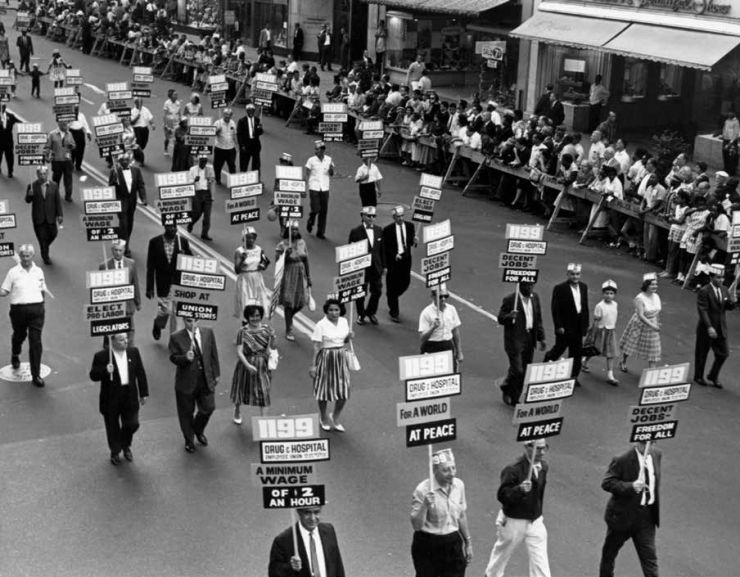Our History: ‘ A Good Union Doesn’t Have to be Dull’
September 21, 2021
1199 Labor Day Street Fair was launched in 1979.

Some 75,000 New Yorkers flocked to the 1979 daylong event of films, music, comedy, magicians, clowns, jugglers, dancers, health screening and a variety of ethnic foods. The activities took place one city block from the Union’s Midtown headquarters.
Dozens of members took turns working the booths. Some provided blood pressure tests. Others offered nutrition counseling and some led exercise classes. A central feature of the first and subsequent fairs through the mid 1980s were labor-themed films shown at the Harold Clurman Theatre on West 42nd Street.
Films often focused on the struggles of working women, such as “Salt of the Earth,” about a New Mexico zinc miners’ strike; “The Life and Times of Rosie the Riveter,” which chronicled women factory workers during WW II, and “Double Day,” about South American women struggling to work while raising families.
A highlight of several Fairs was the Bread and Puppet Circus Theater, a Vermont progressive collective whose central principle was that theater should be like bread—a necessity for the sustenance and wellbeing all.
At the first Fair, workers from other unions erected booths and exhibited skills such as cutting and making coats, sewing and even bus driving. A group of women of color who were being trained for the construction trades erected the frame of a small house on the street and spoke to Fair goers while they worked.
The second Fair in 1980 featured the cast of the wildly popular musical “Take Care,” which grew out of a 14-week series of workshops in which 1199ers discussed the details of their work and home lives. The workshop material was transformed into songs and sketches by Ossie Davis, Mikki Grant, Eve Merriam, Alan Menken and Lewis Cole.
The musical toured forty-five 1199 New York City hospitals. It later made an eleven-state tour and was performed at the U.S. Department of Labor.
‘’We’re proud to present a major public event that celebrates the labor movement,’’ said Foner before the 1981 Fair. ‘’As the only fair sponsored by a labor union, we feel that this year’s event, coming on the 100th anniversary of the founding of America’s first national labor organization—the Knights of Labor in 1881— has special significance to New Yorkers.’’
That year the Fair was moved to Sunday because the city’s Central Labor Council, partly in response to President Ronald Reagan’s vicious assault on the nation’s unions, hosted a Labor Day parade. The Fair continued on Sundays through the mid 1980s. By then, the Labor Day parade had been discontinued as the West Indian Carnival in Brooklyn came to dominate Labor Day festivities.
B&R continued to produce groundbreaking events throughout the years. In a Union where most of the workers rarely had the opportunity to experience live theater and other art forms, those events brought both joy and a deeper understanding to members.
The events also built unity by showcasing the art and culture of the Union and the city’s various racial and ethnic groups.
“What our union and our members are doing,” 1199 President Leon Davis said at the time, “is merely demonstrating again what most labor leaders know —that the fight for a living wage and decent working conditions is the start of the struggle for all the good things in life.”
The events also had immeasurable publicity and political value. 1199 stood out as an organization that was ahead of its time by pointing the way to the need for a more diverse and inclusive labor movement and by building bridges to the artistic, political and progressive communities.
The Union’s relationships and reputation held it in good stead during contract, budget and legislative campaigns. Its use of the various forms of art and culture helped members and allies to understand that the good things in life were rights for everyone, not privileges for the few.
1199 Magazine | July - August 2021

